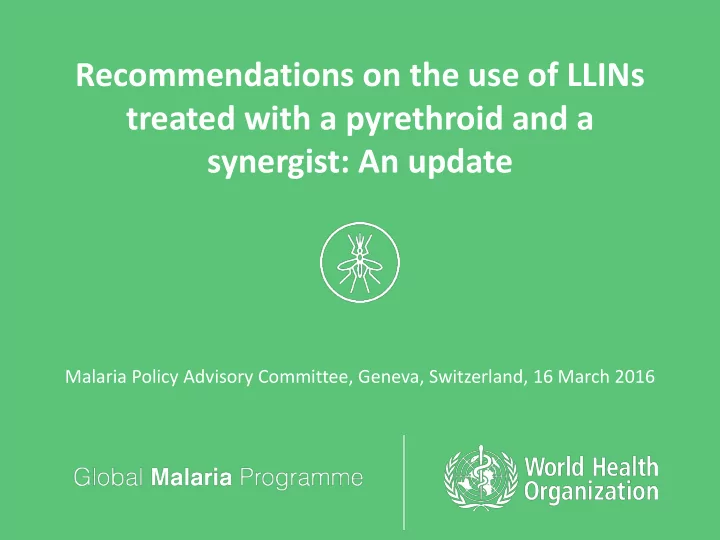

Recommendations on the use of LLINs treated with a pyrethroid and a synergist: An update Malaria Policy Advisory Committee, Geneva, Switzerland, 16 March 2016
Pyrethroid resistance increases in distribution and intensity
Use of PBO LLINs in pyrethroid resistant areas • Three LLINs treated with a pyrethroid and a synergist (PBO) are now available and have a WHOPES recommendation • PBO is a synergist that enhances effects of pyrethroids by inhibiting metabolic detoxification enzymes • Nets treated with PBO are therefore expected to perform better than standard LLINs in areas of substantial pyrethroid resistance – due to presence of certain resistance mechanisms (e.g. mixed function-oxidase) • WHO reviewed the available evidence with the objective of identifying areas and conditions under which PBO nets could be deployed • Advise countries on their use accordingly
Current WHO policy setting process Vector control tools and products WHO Global Malaria Programme WHO Department of Control of Neglected (Entomology and Vector Control unit ) Tropical Diseases (Vector Ecology and Management unit) WHOPES Strategic & Technical Advisory Group Malaria Policy Advisory Committee (STAG) (MPAC) Vector Vector Evidence Working Expert Control Control Review groups Committees Advisory Technical Group Group Expert Group (Temporary) (Standing) (Standing) (Standing) (Temporary) Deployment guidance on NTDs Early guidance Deployment guidance on malaria (TPPs) • Review and assess the concept/proof of principle of new tools/technologies Make recommendations to WHO to further determine the appropriate use under programme • conditions/requirements
The process of reviewing the evidence • Acknowledged by VCAG as a new tool/approach for potential use in areas of high resistance – Nov’14 • Presented to MPAC for a possible recommendation – March’15 following electronic input from VCTEG • MPAC requested GMP to consolidate all available data and if possible commission the generation of new evidence to identify areas where PBO nets could be deployed • GMP requested the consolidation of such evidence and constituted an independent Evidence Review Group (ERG) – Sept’15 • Report electronically reviewed by VCTEG and MPAC – October’15 • WHO issued recommendations – December 2015
Quality of the evidence (i) • Laboratory data on the comparative efficacy of a pyrethroid-only LLIN versus a PBO LLIN against pyrethroid-resistant populations were available from 28 studies , providing 137 data points. • These bioassay data showed that PBO LLINs can kill most resistant mosquito strains, except in those with very high resistance and with mechanisms unaffected by PBO. • Semi-field data from 9 experimental hut trials supported this finding, however: • Conducted in areas of documented high insecticide resistance • Data were available only for An. gambiae s.l.
Quality of the evidence (ii) • There were some correlation between the data from the bioassays and the limited experimental hut data. However not adequate to rely on predictions of the entomological or epidemiological impact of PBO LLINs. • Data were available from six village trials with entomological, but not epidemiological, outcomes. • No data are available from high-quality cluster randomized trials on the epidemiological impact of PBO LLINs. One trial was under way and thought could help answer some of the outstanding questions. NB: In one product, PBO component was shown not to be available after 10 laboratory washes compared to the required 20 washes for the pyrethroid
Recommendations for PBO nets implementation • The evidence on the efficacy of PBO LLINs is still limited and does not justify at this point, a complete switch from pyrethroid-only LLINs to PBO LLINs across all settings . • There is neither evidence to assume higher efficacy nor greater utility as a resistance management strategy across all settings . • PBO LLINs should be used only where universal coverage with effective vector control (LLINs and / or IRS) of populations at risk of malaria will not be reduced. • They should also not be used in areas programmed for IRS with pirimiphos methyl (actellic-cs) due to a potential negative interaction between PBO and pirimiphos methyl
Recommendations for PBO nets implementation • Pilot implementation accompanied by robust monitoring and evaluation undertaken where prevalence of malaria in children aged 2 – 10 years is > 20% and mosquito bioassay mortality with pyrethroids is < 80% • Guiding potential deployment, countries should be supported to: • collect data on the presence, level, intensity and mechanisms of pyrethroid resistance at representative sentinel sites; • design an evaluation with appropriate indicators based on detailed guidance • To manage insecticide resistance, development and evaluation of non-pyrethroid LLINs and other innovative vector control tools for use across all settings is a priority
Recommend
More recommend